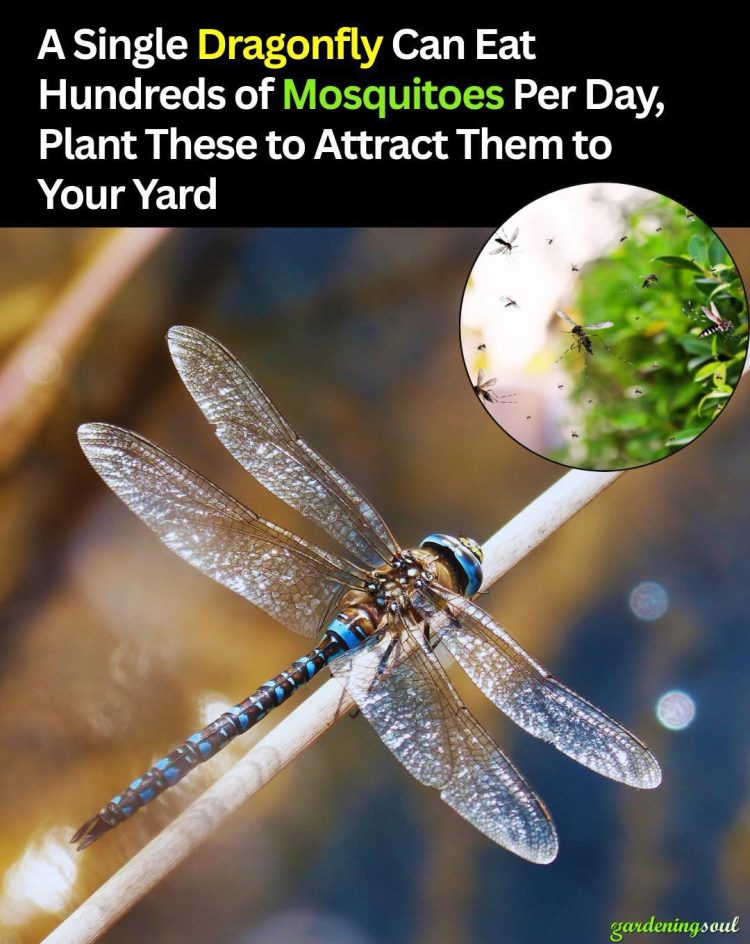Dragonflies are not only fascinating creatures to watch as they dart and hover around your yard, but they are also nature’s pest control experts.
A single dragonfly can consume hundreds of mosquitoes per day, making them a valuable ally in the fight against these pesky and potentially disease-carrying insects.
If you’re looking to reduce the mosquito population in your yard naturally, attracting dragonflies is an excellent strategy.
In this article, we’ll explore how dragonflies help control mosquitoes, the plants that attract them, and other tips to create a dragonfly-friendly environment.
Why Dragonflies Are Nature’s Mosquito Control
Dragonflies are voracious predators, both in their larval and adult stages. They are known to eat mosquitoes, gnats, flies, and other small insects, making them a natural and eco-friendly solution for pest control. Here’s why dragonflies are so effective:
High Appetite for Mosquitoes: A single dragonfly can eat anywhere from 30 to hundreds of mosquitoes in a single day. Their diet primarily consists of small flying insects, and mosquitoes are a favorite.
Larvae Are Equally Effective: Dragonfly larvae, also known as nymphs, live in water and feed on mosquito larvae, preventing them from maturing into adults.
Eco-Friendly Pest Control: Unlike chemical insecticides, dragonflies do not harm the environment or other beneficial insects like bees and butterflies.
By attracting dragonflies to your yard, you can significantly reduce the mosquito population without resorting to harmful chemicals.
How to Attract Dragonflies to Your Yard
Dragonflies are attracted to environments that provide food, water, and shelter. Here are the key steps to create a dragonfly-friendly yard:
1. Add a Water Feature
Dragonflies spend most of their lives near water, as they lay their eggs in aquatic environments. Adding a water feature to your yard is the most effective way to attract them. Consider the following options:
Ponds: A small garden pond with shallow edges is ideal for dragonflies. They prefer still or slow-moving water where they can lay their eggs.
Water Gardens: Incorporate aquatic plants like water lilies and cattails to create a natural habitat.
Birdbaths or Fountains: While not as effective as ponds, these can still attract dragonflies if placed strategically.
Ensure the water is clean and free of chemicals, as dragonflies are sensitive to pollution.
2. Plant Dragonfly-Friendly Plants
Certain plants attract dragonflies by providing perching spots, shelter, and attracting their prey. Here are some of the best plants to include in your yard:
Aquatic Plants for Water Features
Water Lilies (Nymphaea spp.): These provide resting spots for dragonflies and attract insects they feed on.
Cattails (Typha spp.): These tall plants offer shelter and are commonly found in dragonfly habitats.
Pickerelweed (Pontederia cordata): This plant thrives in shallow water and attracts dragonflies with its vibrant flowers.
Marginal Plants for Pond Edges
Blue Flag Iris (Iris versicolor): This plant grows well in wet soil and adds beauty to your pond while attracting dragonflies.
Arrowhead (Sagittaria latifolia): Known for its arrow-shaped leaves, this plant provides excellent cover for dragonfly larvae.
Garden Plants for Shelter and Perching
Black-Eyed Susan (Rudbeckia hirta): These bright flowers attract small insects, which in turn attract dragonflies.
Joe-Pye Weed (Eutrochium purpureum): This tall plant provides perching spots and attracts pollinators.
Milkweed (Asclepias spp.): While known for attracting monarch butterflies, milkweed also draws in dragonflies.
Yarrow (Achillea millefolium): Its flat-topped flowers are perfect for dragonflies to rest on.
3. Avoid Pesticides
see continuation on next page
